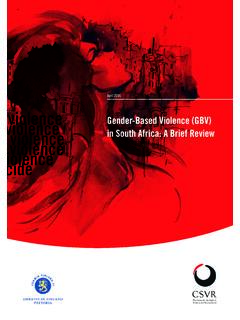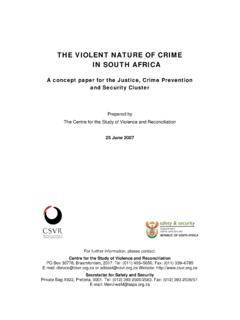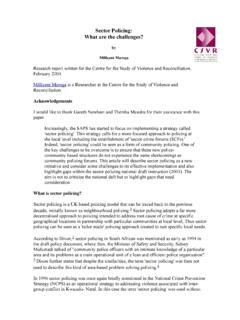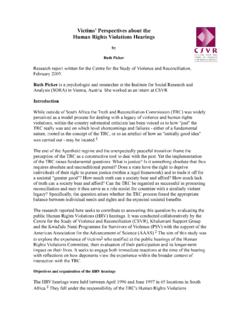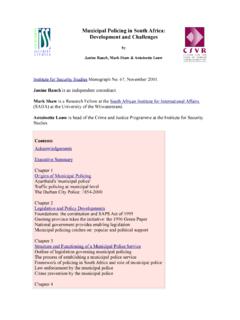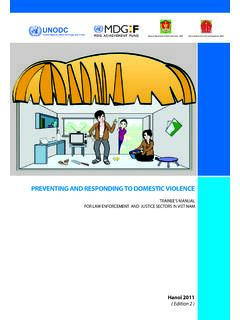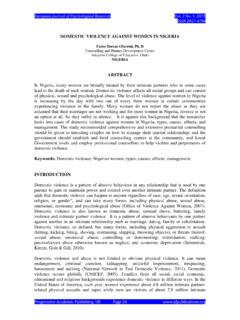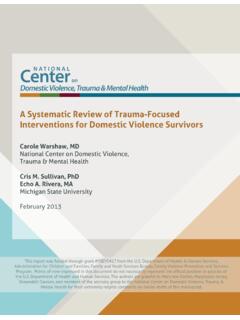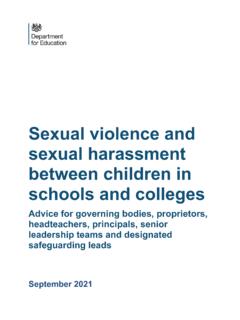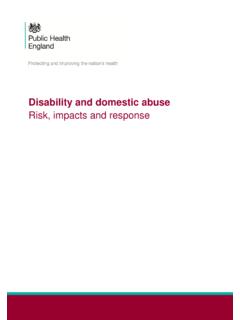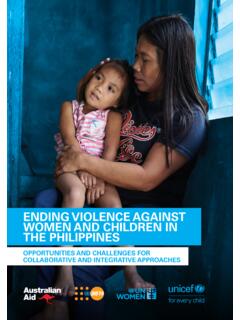Transcription of Gender–Based Violence in SA - CSVR
1 April 2016. Violence Gender-Based Violence (GBV). Violence in South Africa: A Brief Review Violence Violence iolence cide Acknowledgments This study was generously funded by the Finnish Embassy. Special thanks to Nonhlanhla Sibanda and Thandi Msibi for their support during the management of this research project, and to the reviewers for their critical comments on the first draft of the report. Gender- Based Viol ence (GBV) i n South Afri ca: A Bri ef Revi ew Table of Contents Executive Summary 2. introduction 3. Defining gender-based Violence 4. Selected forms of gender-based Violence 5. domestic Violence Physical Violence Emotional Violence Economic Violence Sexual Violence Femicide South African trends and patterns of gender-based Violence 6.
2 Brief statistics Root causes of gender-based Violence 8. The influences of culture, tradition and religion on gender-based Violence 8. Lobola 8. Ukuthwala 8. Virginity testing 9. Female genital mutilation 9. Male circumcision 10. Sharia law 10. Individual factors and gender-based Violence 11. Economic factors and gender-based Violence 12. Alcohol abuse and gender-based Violence 12. Guns and gender-based Violence 13. Legal factors 13. The role of the police 13. Access to courts 14. Budgetary constraints 14. Lack of cooperation among government departments 14. Consequences of gender-based Violence 15.
3 Concluding remarks 16. References 17. 1. Gender- Based Viol ence (GBV) i n South Afri ca: A Bri ef Revi ew Executive Summary The Centre for the Study of Violence and Reconciliation (CSVR) conducted this brief literature review about Gender-Based Violence (GBV) with the aim of using the findings to inform its gender Violence prevention initiatives in various communities. It is clear in this report that the cause of GBV cannot be attributed to a single factor, but an interplay of individual, community, economic, cultural and religious factors interacting at different levels of society. All these factors ranging from gender inequalities between men and women, social constructions of hegemonic masculinities, social perceptions of what it means to be a man, normalisation of Violence , and cultural practices such as lobola and ukuthwala are discussed in the report.
4 The report also discusses how the state's failure to implement GBV-related policies and legislation also contributes to the problem. It is argued in the report that legislation cannot operate in isolation. It is critical that its drivers are understood in order to develop evidence-based interventions to address it. It is therefore important that the full context is taken into account, including how interventions aimed at addressing GBV are implemented and evaluated. 2. Gender- Based Viol ence (GBV) i n South Afri ca: A Bri ef Revi ew introduction Of the 87 countries covered by the Organisation for levels through a series of goals and actions derived Economic Cooperation and Development's 2012 Social from legally binding international, continental and Institutions and Gender Index, South Africa was ranked regional fourth (the highest in Africa) in making progress in terms of gender equality and women's South Many SADC countries have also signed and ratified Africa was second in Africa after Rwanda in terms various international conventions ( Beijing Platform of female representatives in parliament, at 45%.)
5 2 for Action [BPFA], 1995; UN Resolution 1325 on Women, These achievements are in line with Goal 3 of the UN Peace and Security, 2000; and the Protocol to the African Millennium Development Goals, which advocate gender Charter on Human and People's Rights on the Rights equality and the empowerment of women. International of Women in Africa, 2003) as a sign of commitment to declarations and local legislation show that gender- eradicating GBV in their respective countries. Despite based Violence (GBV) is a major obstacle to the these efforts, GBV still remains a major human rights achievement of equality, development and peace as violation in Africa, including South Africa, which is the Violence impairs women's ability to enjoy basic human focus of this report.
6 Rights and freedoms as enshrined in various policies and conventions, such as the 1995 Beijing On the whole, South Africa has made strides in uplifting women in the country. However, despite this progress, recognises gender equality as a fundamental human GBV still remains unacceptably high. Cultural, religious, right and an integral part of regional integration, social and economic factors play a role in driving GBV. It economic growth and social development. SADC is the aim of this report to critically discuss the causes is therefore committed to removing all forms of of GBV so that sound interventions can be developed to gender inequalities at the regional and national deal with it.
7 1. Statistics South Africa, Gender Statistics in South Africa, 2011,' (accessed 28 January 2016), vi. 2. Ibid. 3. United Nations, Fourth World Conference on Women: Beijing Declaration,' September 1995, (accessed 27 January 2016). 4. Southern African Development Community, SADC Gender Policy,' (accessed 27 January 2016), 3. 3. Gender- Based Viol ence (GBV) i n South Afri ca: A Bri ef Revi ew Defining gender-based Violence GBV is defined in various ways by different researchers and includes violations of the rights of women in situations of armed organisations. It is the general term used to capture Violence that conflict, such as systematic rape, sexual slavery, forced pregnancy, occurs as a result of the normative role expectations associated forced sterilisation, forced abortion, coerced or forced use of with each gender, as well as the unequal power relationships contraceptives, prenatal sex selection and female infanticide.
8 Between the genders within the context of a specific society It further recognised the particular vulnerabilities of women (Bloom 2008: 14). The focus of this report is on women and girls belonging to minorities: the elderly and the displaced; indigenous, as victims of GBV, but this is not to say that men and boys are not refugee and migrant communities; women living in impoverished also sometimes victims. Statistically, however, females are more rural or remote areas; and women in likely to be victims than males (Anderson & Umberson 2001; Bloom 2008; Jewkes et al. 2010). According to the UN Population Fund, These definitions of GBV are also relevant in South Africa.
9 South Africa has ratified the BPFA, the SADC Declaration on Gender and the primary targets of GBV as victims are women and Development, the UN Convention on the Elimination of All Forms of adolescent girls, but not only are they at high risk of GBV, Discrimination against Women and other international instruments they also suffer exacerbated consequences as compared (Commission for Gender Equality 2010). The development of with what men endure. As a result of gender discrimination various pieces of legislation, such as the domestic Violence Act and their lower socio-economic status, women have fewer (No.)
10 116 of 1998), the Criminal Law (Sexual Offences and Related options and less resources at their disposal to avoid or Matters) Amendment Act (No. 6 of 2012), the Maintenance Act (No. escape abusive situations and to seek justice. They also 99 of 1998), the Protection from Harassment Act (No. 17 of 2011). suffer ( ) consequences [on their sexual and reproductive and many others has been influenced by various international health], including forced and unwanted pregnancies, unsafe instruments to deal with GBV. It is well known that South Africa abortions and resulting deaths, traumatic fistula, and higher has effective policies to address GBV, but the limitation is in the risks of sexually transmitted infections (STIs) and implementation.
